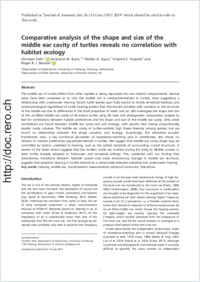Comparative analysis of the shape and size of the middle ear cavity of turtles reveals no correlation with habitat ecology
- Foth, Christian Department of Geosciences, University of Fribourg, Switzerland
- Evers, Serjoscha W. Department of Geosciences, University of Fribourg, Switzerland - Department of Earth Sciences, University of Oxford, UK
- Joyce, Walter G. Department of Geosciences, University of Fribourg, Switzerland
- Volpato, Virginie Department of Geosciences, University of Fribourg, Switzerland
- Benson, Roger B. J. Department of Earth Sciences, University of Oxford, UK
-
2019
Published in:
- Journal of Anatomy. - 2019, vol. 235, no. 6, p. 1078-1097
English
The middle ear of turtles differs from other reptiles in being separated into two distinct compartments. Several ideas have been proposed as to why the middle ear is compartmentalized in turtles, most suggesting a relationship with underwater hearing. Extant turtle species span fully marine to strictly terrestrial habitats, and ecomorphological hypotheses of turtle hearing predict that this should correlate with variation in the structure of the middle ear due to differences in the fluid properties of water and air. We investigate the shape and size of the air‐filled middle ear cavity of 56 extant turtles using 3D data and phylogenetic comparative analysis to test for correlations between habitat preferences and the shape and size of the middle ear cavity. Only weak correlations are found between middle ear cavity size and ecology, with aquatic taxa having proportionally smaller cavity volumes. The middle ear cavity of turtles exhibits high shape diversity among species, but we found no relationship between this shape variation and ecology. Surprisingly, the estimated acoustic transformer ratio, a key functional parameter of impedance‐matching ears in vertebrates, also shows no relation to habitat preferences (aquatic/terrestrial) in turtles. We suggest that middle ear cavity shape may be controlled by factors unrelated to hearing, such as the spatial demands of surrounding cranial structures. A review of the fossil record suggests that the modern turtle ear evolved during the Early to Middle Jurassic in stem turtles broadly adapted to freshwater and terrestrial settings. This, combined with our finding that evolutionary transitions between habitats caused only weak evolutionary changes in middle ear structure, suggests that tympanic hearing in turtles evolved as a compromise between subaerial and underwater hearing.
- Faculty
- Faculté des sciences et de médecine
- Department
- Département de Géosciences
- Language
-
- English
- Classification
- Palaeontology
- License
-
License undefined
- Identifiers
-
- RERO DOC 327414
- DOI 10.1111/joa.13071
- Persistent URL
- https://folia.unifr.ch/unifr/documents/308140
Other files
Statistics
Document views: 156
File downloads:
- pdf: 306
- Supplementary material: 147

